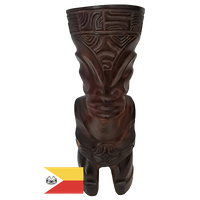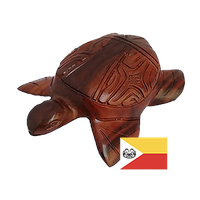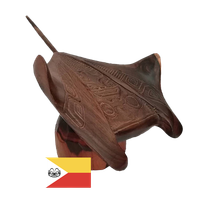Wood Carving from the Marquesas Islands - The Land of Men
The Marquesas Islands, home to some of the finest craftsmen in French Polynesia. Hand carved wood sculptures of Tikis, Sea turtles and Manta Rays

The Marquesas Islands - The Land of Men
The Marquesas Archipelago is one of the most remote island groups in the world. They are located about 930 miles northeast of Tahiti and are known as 'The Land of Men'. They are split into two groups, Te Henua 'Enana (North Marquesan) and Te Fenua 'Enata (South Marquesan).
Unlike other islands of French Polynesia, there are no lagoons protecting these landscapes. Surrounded by steep volcanic cliffs that emerge from the Pacific Ocean, the coastlines of the Marquesas Islands are a mix of black sand beaches and beautiful bays. The sharp mountain peaks with jagged ridges lay interspersed between deep valleys and thriving lush jungles.

Research suggests the islands were first colonized sometime between the 9th and 11th centuries AD by the voyagers from West Polynesia. Then later, in 1595, they were 'discovered' by the Spanish navigator Alvaro de Mendaña who named the archipelago 'The Marquesas' after the 16th century Spanish Viceroy of Peru, the Marquis of Cañete.
The Marquesas are spread out over 12 islands and form one of the five administrative divisions of French Polynesia with the town of Taiohae on the island of Nuku Hiva acting as the capital. Only six of the islands are inhabited with a total population of slightly over 9000.
Marquesan Wood Carving
The Marquesan wood sculpters, known as tuhuna, are considered as the finest craftsmen in French Polynesia and their work of consistently high quality is much sought after.
The preferred materials to make the wood sculptures are mainly the noble woods such as Oceania rosewood (Miro or Mi'o), Oceania walnut (tou) and Ironwood (aito) but the wood from the coconut tree (tumu ha'ari or tumu 'ehi) is also used.
It is important to the Marquesan people to use wood from the islands because of its quality and also to follow the traditions of their ancestors. Typically, the craftsmen cultivate the trees in their own gardens, leaving it to dry for up to 10 years before treating it against pests and preparing it to be carved.
New styles and techniques of wood carving emerged in the late 19th century due to the introduction of metal carving tools and craftsmen began to decorate and carve the full surface of the pieces with low-relief designs, similar to the tattoo designs seen on the Marquesan people. This was done to meet the increase in demand for their works exported to foreign countries throughout the world.
Common objects include sculptural representations of Polynesian gods, humans and animals, and utilitarian items such as decorated bowls, paddles, and clubs.



